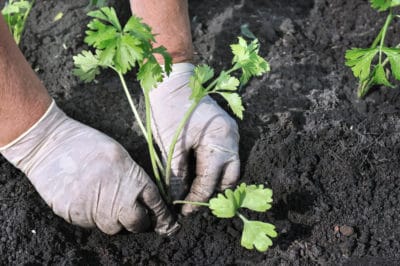Climate and Planting Celery
Celery’s reputation for being difficult is often climate-related. It prefers cool weather and is temperature-sensitive. In temperate climates, celery is best grown as an early spring crop so it can be harvested well before summer’s heat. With careful management, it can also be planted in later summer for a late fall harvest. Gardeners in the desert or very hot summer areas will have better results by planting celery as a winter crop.
Soil Preparation
Celery originated as a bog or swamp plant. It likes very fertile, moist soils that also drain well. A sandy loam is ideal, but if your soil is heavy clay, amend it with sand and humus such as well-aged manure, compost or rotted leaves. Mix in an organic 5-10-10 fertilizer to supply the nutrients it demands – celery is a shallow-rooted but heavy feeder.
Choosing Varieties
Celery is available in both open-pollinated and hybrid varieties as well as different colors. Some celery is also self-blanching. Here are some good varieties:
- Ventura – 80-100 days, open-pollinated, performs well in heat.
- Tango Green – 80 days, hybrid, self-blanching.
- Red Venture – 84 days, hybrid, stems red on interior.
- Golden – 105 days, open-pollinated, self-blanching and turns golden yellow by fall.
Germinating Seeds
Celery seed can be hard to germinate. Sow seed indoors in pots or flats about 10 to 12 weeks prior to the last expected spring frost. Seeds need light to germinate, so barely cover the seed. Ideal soil temperature for germination is about 70 to 75°F (21 to 24°C). Seedlings grow best in temperatures of about 60 to 70°F (16 to 21°C). Germination can take two weeks.
Transplanting
Grow celery seedlings indoors, transplanting once when the plants are about three inches tall. Harden off seedlings by moving them outside in the daytime for a few hours two weeks prior to planting them outside. Keep them inside at night, however. Place four- to six-inch transplants in the ground around the date of the last spring frost, spacing eight inches apart. Mound soil slightly around roots.
Care and Management
For best results, keep the celery growing constantly. This means a steady supply of water and nutrients. Never let soil dry out. Side dress plants at least twice in the growing season by placing one tablespoon of organic 5-10-10 fertilizer in a shallow trench several inches away from the plants. Watering with manure or compost tea provides both moisture and nutrients.
